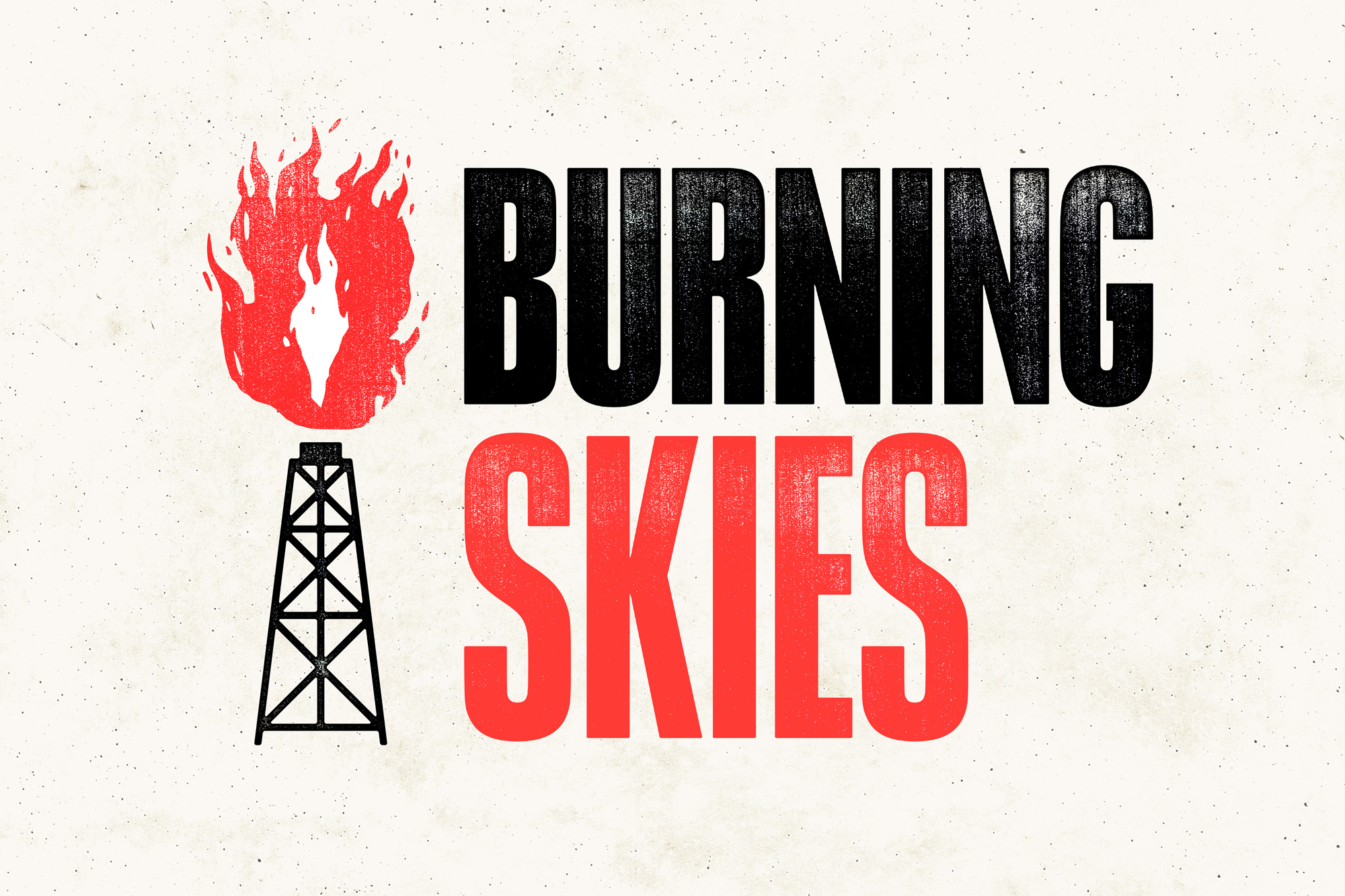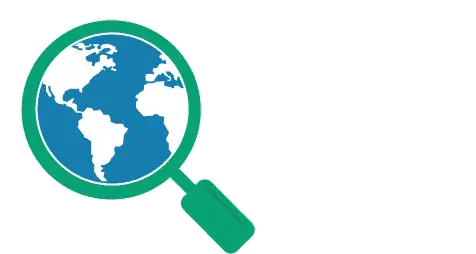©Illustration: Justine Vernier & Simon Toupet / Mediapart
Our investigative series “Burning Skies”, led by EIF in partnership with EIC, Daraj Media, SourceMaterial and Oxpeckers Investigative Environmental Journalism reveals for the first time the true toll of gas flaring in Africa and the MENA region.
Flaring, which consists of oil and gas companies burning off excess natural gas from their hydrocarbons fields, terminals and refineries, comes at catastrophic costs for exposed populations and biospheres, as well as climate. This infamous practice reamins one of the main drivers of greenhouse-gas emissions within the fossil fuel sector.
According to the latest annual report from the World Bank, flaring emitted 381 millions tons of CO2 equivalent worldwide in 2023, representing 1% of global carbone dioxyde emissions. This is more than the annual emissions of a country such as France for the previous year.
But the true toll behind these burning flames remains largely uncovered, mainly due to a lack of corporate transparency on the matter. Available data only provides total emissions by country, but no detailed information by operator.
While several multinationals joined the initiatives of the World Bank and the Carbon Disclosure Project (CDP), such operators only declare flaring figures taken from a global perspective, without providing any detail by country – or by asset.
For the first time, our “Burning Skies” investigative series reveals the individual responsibilities of big oil companies behind this destructive practice.
Using satellite and geo-data provided by the Earth Observation Group of the Payne Institute for Public Policy and the environmental NGO Skytruth, completed with open source research, we linked thousands of these flaring signals to over 650 oil and gaz infrastructures, in 18 countries of Africa and the Middle East.
Our consortium managed to estimate emissions from 2012 to 2022 in the two regions, and attribute them to the operating companies, for each oil field, LNG plant or refinery.
European oil giants emerged from our analysis as the worst CO2e emitters when it comes to flaring, according to our estimates.
Five European majors rank in the top ten of our estimates, including the British BP (2nd), the Italian (3th), the French TotalEnergies (5th), the French-British Perenco (6th), but also the Dutch-British Shell (7th).
The largest emitter by far among these 18 countries is the Algerian state-owned company Sonatrach. The public company emitted 235 million tons of CO2e in a decade, almost four times more than TotalEnergies. Contacted by our partner Daraj, Sonatrach did not provide any comment on these findings.
TotalEnergies stated to Mediapart that using “satellite imagery”, was “strongly unprecise compared to on-site measurements” and could lead to “overestimates”, but the company could not provide its own list of estimates for each of its operated sites.
The morbid trail of methane
Flaring happens for a variety or reasons at different stages of the fossil fuel supply chain. Most often it occurs for safety measures in order to get rid of unwanted gas excess that could lead to an explosion. It the most common alternative to « venting » this methane, an even more devastating practice, as direct gas releases are 84 times more potent than CO2 over a span of 20 years.
Flaring will rather burn any excess of methane, converting it into CO2 in the process. But this alternative still comes with a price for climate, while also producing a toxic cocktail of volatile compounds, nitrogen oxides and fine particle matter.
These compounds can impact the local fauna and flora, but also endanger the health of millions of people living near the flaring hotspots, causing respiratory and skin diseases, cancers and premature births. A recent study published in the Journal of Public Economics states that such impact on human health starts occuring within 90km radius of a flaring source.
Our partner newsrooms Daraj, NRC, SourceMaterial, Oxpeckers and Mongabay visited seven countries to report on the catastrophic impacts of flaring on local populations, with entire residentials areas being exposed within a 10km radius only from these toxic flares operated by oil majors such as BP, ENI, Shell or TotalEnergies.
Questioned by our partner NRC regarding local population exposures to its operating sites in Nigeria, Shell stated that its “right-of-way” had been “encroached” by local communities.
“Many of our oil and gas producing facilities were not originally sited in densely populated areas”, Shell indicated, adding that it “continue to work with state governments and other stakeholders to discourage communities from encroaching into operational areas”.
Who will pay the bill?
Despite governmental and corporate pledges, the fight against flaring is a failure. According to the World Bank, flaring emissions rose by 7% in 2023 compared to the previous year, and no decrease has been recorded when comparing with the year 2010. The International Energy Agency (IEA) also warns that global gas flaring is « not on track » to meet the « Net Zero by 2050 » goal.
“There is urgency to take action”, reads the latest World Bank report published in June 2024. « This places the burden of responsibility on operators to ensure that oil and gas are produced as cleanly as possible during the energy transition », the report insists.
Flaring is also a massive source of energy waste, despite the existence of mature technology to recover methane and use it to generate electricity. A much needed source of energy which could be used by African and Middle Eastern countries who regularly suffer from electricity shortages. Flared methane volumes, if properly reused, would be enough to « power the whole of sub-Saharan Africa », still according to the World Bank.
According to the World Bank and the EIA, investments worth 200 billion dollars would be enough to both cut raw methane emissions and end routine flaring. This represents only 5% of the global net income of the fossil fuel sector (4000 billion dollars in 2022).
Big oil companies dud build flaring reducing facilities on some of their fields, but they are still reluctant to invest on a massive scale – flaring is simply cheaper, and any recovery process could actually negatively impact production.
« The flow that reaches the torch is variable, so it is not manageable. A constant flow is needed to produce electricity », says José Antonio García Fernández, professor of Chemical Engineering at the Bilbao School of Engineering.
« When we investigated flaring in Iraq with the BBC, an engineer told us that because of these pressure problems, in order to recover more gas, you need to reduce oil production, but oil companies chose to preserve production », also explained Aidan Farrow, senior scientist at Greenpeace international science unit.
Governmental complicity
According to Farrow, the main reason behind the failure in reducing flaring emissions is the “lack of legislations that actually have some teeth and some consequences”, as our investigation confirms.
Our data reveals that during the past decade, oil companies have emitted an estimated volume of 451 million tons of CO2e in 9 African countries where flaring is prohibited by law or authorized only exceptionally, for a short period of time. More than half of these volumes (263 million tons) have been emitted by western oil majors like TotalEnergies and BP.
In contradiction their own regulations, developing countries appear quite tolerant towards flaring, in order to maximize revenues and production. The situation is no better in countries where flaring is either poorly regulated or inexistent, such as Iraq and the UAE.
The European Union, which is the world’s biggest hydrocarbons importer, has long turned a blind eye. A new EU regulation destined to tackle methane emissions of the energy sector has come into force on June 13th, 2024, but it is considered to be insufficient by environment activists.
The regulation bans both venting and flaring on EU territory, except exceptionally for safety reasons. But the text is much more flexible regarding imports. Europe will prohibit oil and gas imports of high “methane” intensity from August 2030, but the maximum methane intensity will only be defined by 2029. In short, there’s no guarantee that the EU will impose that imported hydrocarbons must be as clean as the ones produced on its territory.
The limits of voluntary pledges
Today, the fight against flaring relies largely on voluntary international initiatives initiated by the World Bank, whose efficiency is very questionable.
The Global Flaring and Methane Reduction Partnership (GFMR), launched in 2023 at COP28, is composed of governments, multilateral organizations, and oil companies, who pledged to provide $255 million worth of « new grant funding ». But this is a tiny fraction of the $100 billion needed, according to the World Bank itself, to end « routine flaring », meaning the fact of burning gas continuously, and not only for safety reasons.
The World Bank’s flagship programme, called Zero Routine Flaring Initiative (ZRF), was launched in 2015. It has been endorsed by governments and oil companies, including all of the top flaring operators revealed by our investigation – with the exception of Perenco.
ZRF signatories have pledged to end routine flaring by 2030. But in their declarations to the World Bank, the seven European oil companies (BP, ENI Equinor, Repsol, Shell, TotalEnergies and Wintershall) declared that, on average, they consider that only 32% of their flaring is « routine » in 2022.
Despite huge emissions level, BP considers that only 1.7% of its flaring is routine, and TotalEnergies only 17.5%, whereas ENI and Repsol declare that it’s over 50%.
In other words, even if these companies would respect these pledge, the vast majority of their emissions will remain.
Not to mention the fact that disparity of rates among all of these companies really casts a doubt on the accuracy of their respective emission-counting methodologies.
These figures also seem to be contradicted by a study published by IEA, which states that 66% of worldwide flaring is routine. Asked by EIC, Tomás de Oliveira Bredariol, Energy and Environmental Policy Analyst at EIA, explains that the study defines routine flaring as the flares « operating more than 85% of the time », and points out that « companies may consider a different definition ».
Zubin Bamji, manager at the Global Flaring and Methane Reduction (GFMR), estimates that flaring routine represents an average of “~70% of total flaring” across the globe. According to Bamji, rates as high as 100% have been declared on a country-level in Niger and Cameroon, and as low as zero percent for Denmark or Saudia Arabi.
There is, as of today, neither a common definition nor an independent verification of routine flaring volumes. Which is very convenient for the fossil fuel sectors and its top emitters.
« What we need is to track flaring with direct measurements and monitoring – and we have all the tools to do this today, comments Daniel Zavala-Araiza, a researcher at the NGO Environmental Defense Fund and Utrecht University. Beyond this problem of definition of routine flaring, it’s flaring as a whole that needs to be significantly reduced. »
How Flaring is underestimated
Hydrocarbon producers also have a tendency to underestimate their responsibility. All the European majors declare only the emission volumes of the assets that they operate. Several oil and gas giants don’t take into account various fields where they have a minority shareholding, despite the fact that they directly profit and enable various operations and processes on these locations.
One of the most striking examples is Rumaila in southern Iraq – the most polluting oil field in our investigation – with more than 105 million tons of CO2e flared between 2012 and 2022. The British Oil giant BP considers that it has no responsibility, despite owning 47.63% of Rumaila and being listed as an operator by the Iraqi oil register during this period.
Even when taking only operated assets into account, we also observed discrepancies between the results of our Burning Skies investigation and the declarations of some European majors, which suggests that they under-report their emissions.
In the case of BP’s emissions figures, we estimated that for only 18 countries, the company’s emissions were 2 times more than what BP’s worldwide self-reported emissions. The company told our partners at Source Material that it is “working to manage and reduce flaring in our operated assets”, but did not comment this disrepancy.
Similarly, for ENI, our estimations found over 2.8 times the amount of CO2 emissions that the company declared globally during the same period.
Contacted by our partner Domani, ENI stated that the original data we had used “do not allow to individually identify assets and associate them with the relevant operator” and asked to review the list of assets we took into account. After being provided with the list, the company indicated that “some assets are not operated or are outside of ENI’s perimeter”, but did not specify which ones.
On top of this, two recent scientific studies consider that flaring emissions estimates, measured in CO2 equivalent, could actually be dramatically higher than what was previously thought. The scientific standards used by the World Bank (that we also used in our investigation), consider that 98% of the methane sent to the flare is burnt – that’s the “burning efficiency”.
Changes in efficiency rates can have a major impact on calculations: as methane has a much higher warming effect than CO2, if less gas is burnt, overall emissions could be sensibly higher. For the World Bank, a 92% burning efficiency leads to 30% more CO2e equivalent emissions.
A first study, conducted in 2021 by the NGO Environmental Defense Fund (EDF), measured real life « burning efficiency » in the Permian basin, the biggest oil production area in the USA, using satellites and helicopters with infrared cameras. The study revealed that companies emit 3.5 times more methane than they report to the US Environmental Protection Agency.
A second study, published in 2022 in the peer-reviewed academic paper Science, and conducted in three oil producing regions of the USA, confirmed these findings, and found that 91% of the methane is burnt instead of 98%, suggesting a “substantial under-accounting” of flaring-related emissions.
« In other countries around the world, flares are even less efficient, burning under 91% of associated gas », warns EDF researcher Daniel Zavala-Araiza. « Moreover, it happens that the flares are turned off, the flow of methane is maintained and the companies do not report incidents, the real emissions are very high », he adds.
Another aggravating factor is the production of soot from gas flaring. This fine particulate matter, also known as “black carbon”, is considered to be 1500 times stronger than CO2 and derives from the incomplete combustion of fossil fuels.
The European Geosciences Union considers that flaring may contribute to 40 percent of the annual black carbon deposits in the Arctic, which are deemed to be released during near-future ice-melt. However, due to the lack of understanding regarding flares efficiency worldwide, black carbon isn’t accounted for in the current flaring reporting standards.
« It is important that flaring and methane leaks are reduced, but I doubt that the issue can be solved only with investments and technology », says Greenpeace’s senior scientist Aidan Farrow. « We should look at the bigger picture. The problem of flaring shows that we need to move away from fossil fuel use. »
Alexandre Brutelle and Leopold Salzenstein (EIF), Yann Philippin (Mediapart)
About this investigation

This investigation is part of the series “Burning Skies: Behind Big Oil’s toxic flames”, developed by EIF in partnership with the European Investigative Collaborations network, and our partners Daraj, Source Material and Oxpeckers Investigative Environmental Journalism.
Media partners involved in this series include: Mediapart (France), Der Spiegel (Germany), NRC (Netherlands), Domani (Italy), InfoLibre (Spain), Expresso (Portugal), Le Soir (Belgium), Nacional (Croatia) – all EIC members – as well as Daraj (Lebanon), SourceMaterial (UK), Oxpeckers (South Africa), Twala (Algeria), NIRIJ and Al-Mirbad (Iraq).
Using satellite observation data provided by the Group on Earth Observations of the Payne Institute for Public Policy and the environmental NGO Skytruth, supplemented by open source research, we were able to estimate the greenhouse gas emissions caused by flaring for 665 oil and gas infrastructures, from 2012 to 2022, in eighteen countries in Africa and the Middle East: South Africa, Mozambique, Angola, Nigeria, Gabon, Republic of Congo, Cameroon, Equatorial Guinea, Chad, Côte d’Ivoire, Ghana, Algeria, Tunisia, Egypt, Iraq, Oman, United Arab Emirates and Qatar. We then attributed these emissions to the oil companies responsible for them.
This year-long investigation and data analysis was carried out by Alexandre Brutelle and Leopold Salzenstein (EIF), with the collaboration of Mediapart and the EIC. Our full methodology is available here.
Project graphic chart and illustration credits: Justine Vernier et Simon Toupet (Mediapart)
EIF, Daraj and Oxpeckers work for this project was supported by the Journalismfund Europe.
EIF members who participated to this investigation:




